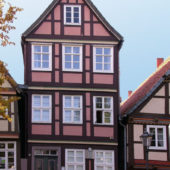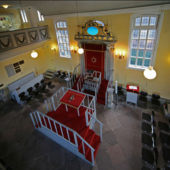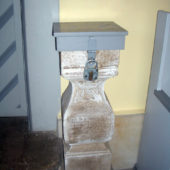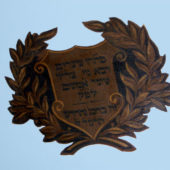The oldest standing half-timbered synagogue in northeren Germany
It wasn’t until 1737 that Jews living in the German principality of Luneburg where Celle is located were granted permission to construct their own houses of worship. In 1738, the Jewish community purchased lots in Celle where they planned to build a synagogue.
However, there is no clear evidence of an exact date of construction or dedication of the synagogue itself. A “Poor Box” inscribed in Hebrew reads, “Aron, son of the Rabbi Josua Feibelman, of blessed memory, in Celle 1740, and offers the best clue as to the actual age of the building.
Celle’s Jewish community assumed a large debt to construct the half-timbered building which today is considered to be the oldest synagogue of its kind in the Lower Saxony region of Germany. From the exterior, the synagogue has a modest, home-like appearance with banks of windows opening onto the street. The synagogue’s interior, with its baroque-style flourishes, is well lit and features a simple rectangular layout, with a women’s second floor gallery overlooking the main hall and a centrally placed bimah.
The extensive debt for the synagogue’s construction was not fully paid off until 1797 and only then thanks to a large bequest from Isaak Jacob Gans, a man with connections to the local Duke. Earlier Gans had paid for a pair of Torah Crowns and a Torah shield in memory of his father. These items are now in the synagogue’s museum.
The synagogue stood largely untouched for 150 years until 1883 when it was renovated and the women’s gallery was expanded. The interior was painted and a stained glass window also was added. On the eve of Rosh Hashanah (Jewish New Year) in 1883, the synagogue was formally rededicated.
The number of Celle’s Jews, never large, began to decline in the 20th Century. By the time Hitler came to power in 1933, their number had dwindled to just 70 people. By October 1939, just after the outbreak of WWII, only 15 remained in town.
November 9-10, 1938, often called Krsitallnacht or “Night of Broken Glass” in Germany, saw a nationwide pogrom in which hundreds of synagogues were burned, vandalized and looted. Celle’s synagogue was no exception with local Nazis using axes to deface the structure throughout and destroying holy texts and other ritual objects. The synagogue was spared burning, however, because of its proximity to other buildings. Later, the remaining Jews from the region were imprisoned in the synagogue before being shipped off to extermination camps. Plaques in the synagogue’s antechamber honor the memory of those who were lost.
After the war, the synagogue came back into use for a time as surviving Jews and refugees from other regions settled in Celle and waited for the opportunity to emigrate to Israel, the United States or other countries. The city of Celle acquired the building in 1969 and renovated it in 1974 when it was dedicated again by a rabbi, Dr. Nathan Peter Levinson. In 1997, the synagogue’s adjoining house was turned into a museum documenting Jewish life in Celle. The synagogue remains in use by a small Jewish congregation and for special events put on by Celle’s Society for Christian-Jewish cooperation.




